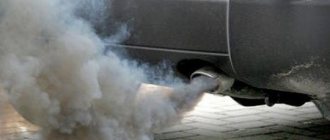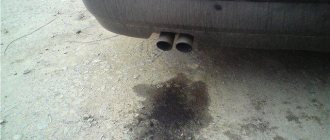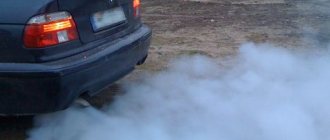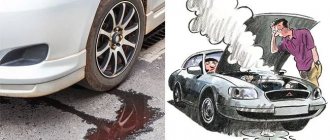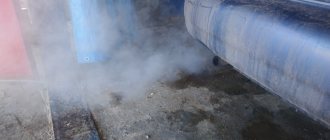Condensation in the muffler car problems in winter often bother their owners. Although in most cases there is no reason to panic, since this phenomenon is most often just normal, since it indicates that the engine and exhaust system are operating normally. However, there are a number of breakdowns (for example, problems with the catalyst, the use of low-quality fuel, a broken cylinder head gasket) that must be eliminated, since they can lead to more serious consequences for the car.
These may include premature failure of the muffler and/or exhaust pipe (due to corrosion of the walls of its housing) or the inability to start the engine (due to frozen condensate in the muffler).
How to get rid of or minimize the amount of water in the muffler, resonator (exhaust system)
Let's start with the fact that it will not be possible to get rid of water in the muffler. This is a dogma and there is no escape from it. At least this cannot be done 100 percent, but it is quite possible to reduce the moisture content. It’s not for nothing that we mentioned temperature in the previous paragraph. It is by changing the temperature of the metal elements of the exhaust system that you can play on the amount of condensate that settles in it, that is, water. Operation is optimal when the car warms up, and the entire exhaust system warms up. Such heating will ensure that less moisture will settle on the walls of the muffler and resonator, and if it does settle, it will quickly evaporate. That is, the conclusion is simple. Long-term operation, rather than one-time and short trips, will help to slightly reduce the water content in the exhaust system of the car.
Is fluid dripping from the exhaust pipe? Don't panic - it's condensation
When starting a car, you can often notice that water is flowing from the muffler while the engine is warming up, and steam is also coming out. This phenomenon is especially noticeable in cold or wet weather, and many car owners are concerned about why water is flowing. But the formation of a vapor cloud and liquid coming out of the exhaust pipe does not always indicate a malfunction of the power unit; condensation is formed according to the law of physics, and no one has yet canceled it. Although in some cases the appearance of water and abundant steam may indicate a broken head gasket, a crack in the cylinder head itself, and then there is cause for concern; engine repair is necessary.
Reasons for the formation of water and steam in the muffler
During operation, internal combustion engines (ICE) of cars heat up to a high temperature; heat removal is provided by the cooling system, but the exhaust tract remains quite hot. So, for example, the exhaust manifold and reception pipe, located in the immediate vicinity of the power unit, can heat up to 500-750ºC, pipes far from the engine, mufflers and resonators do not heat up so much, but the heating here is still very high.
After the engine stops, the steam remaining in the exhaust pipes settles on the walls of the iron, cools down and turns into water. It is for this reason that when a cold engine starts, you can see water splashing from the exhaust pipe; even as it warms up, the car begins to steam (white smoke comes out). But with a working engine, this phenomenon can only be observed when the internal combustion engine is cold; when warmed up to operating condition, all these signs should disappear.
Is it possible to eliminate a water leak from the exhaust pipe?
When warming up in the autumn-winter and early spring, water comes out of the muffler quite often; moisture accumulates especially actively in the exhaust during short trips (it does not have time to evaporate). Another thing is that if steam continues to swirl on a well-heated internal combustion engine, there is cause for concern. Signs of a malfunction in this case may include:
- antifreeze boiling in the expansion tank;
- reducing the liquid level in the cooling system;
- uneven operation of the internal combustion engine at all speeds (engine trouble);
- the appearance of thick steam and drops of moisture from the exhaust pipe during re-gassing;
- temperature increase on the sensor is higher than the permissible norm.
To eliminate the defect, it is necessary to remove the block head and perform diagnostics using a visual inspection. As a rule, a broken gasket is immediately visible; in order to diagnose the cylinder head, a pressure test is performed. Also, the surface of the cylinder head adjacent to the cylinder block may be deformed; in garage conditions, it is checked with a caliper or the even edge of a metal ruler and a feeler gauge for adjusting the valves; if deformed, it is better to level the plane on a milling machine.
If water gets into the muffler naturally (condensation has accumulated), it is unlikely to be completely eliminated. But you can still reduce the release of steam and moisture during warming up like this:
- try to at least sometimes make not only short, but also long trips;
- make small holes in the resonator (muffler) for condensate to escape;
- Carry out a sufficiently long period of accelerating on a warm engine before turning it off.
It should be noted that on some cars, holes for draining condensate in resonators (mufflers) are provided by the manufacturer, so there is no need to modify such elements.
Condensation in the muffler in summer
It’s clear where water accumulates in the muffler in winter and autumn, but why does condensation accumulate in the exhaust system in summer? The answer is quite simple: in the summer there are temperature changes, precipitation occurs, and in some regions there are cold snaps and even sometimes frosts. In dry, warm weather, practically no steam comes out of the muffler pipe, but this does not mean that condensation does not occur. After all, some part of the water in the pipes and “outlet” banks still precipitates, it’s just that on a clear day the steam is not so noticeable in the sun.
Is it possible to reduce the amount of liquid in the exhaust?
The intensity of condensation inside the exhaust system is practically independent of the make and model of the car. It should be understood that a small amount of water in the pipe is normal. The exception is a situation when liquid flows like a river due to a cylinder head gasket failure.
Since you can't control the chemical reaction of gasoline burning to release water vapor, try to combat condensation. What is needed for this:
- reduce the temperature difference between the heated surface of the pipe and the surrounding air;
- reduce the humidity of air in contact with hot flues;
- create conditions for natural evaporation of condensate.
There is only one way to meet these requirements - store the car in a warm, tightly closed garage equipped with exhaust ventilation. Less moisture will fall out of the heated and drier air, and thanks to the positive temperature, the condensate will evaporate during parking and be removed through the hood. Please note that it will not be possible to completely get rid of water droplets from the muffler.
Is condensation in a car dangerous?
Moisture settled in the muffler is a sign of proper operation of the internal systems of the car. Although such a phenomenon does not pose a radical danger, it would be thoughtless to turn a blind eye to it. The main reason for this is corrosion. Experts at domestic service stations claim that exhaust gases are no less aggressive than condensate. But water in a car muffler is still a potential threat, just like any metal liquid. The same applies to the gas tank, engine, and interior - in these places moisture sometimes accumulates in the same volumes as in the muffler.
Features of modification of the muffler for condensate drainage
Not all mufflers rust quickly; there are even inexpensive car models on which the rear canister can last up to 10 years without modification or any repairs (for example, Renault Logan). The metal of the exhaust system on Chinese cars most often succumbs to rust, this applies to Chery, Lifan, Great Wall cars. Also, many non-original spare parts do not last long, so they all need improvement, and draining the water would not hurt. Why the holes are made at the very back of the can, at the bottom and of a certain diameter, is easy to explain:
- if you drill closer to the engine, exhaust gases will partially enter the cabin, which will certainly cause a lot of inconvenience and trouble for passengers and the driver;
- with larger diameter holes, an additional sound of a growling muffler will appear (although some people, on the contrary, like the sound);
- at a higher level of drilling, the water will not completely leave the can, and the rusting process will continue.
Where does the water in the exhaust come from?
Water vapor tends to turn into condensate. In a car, condensation collects in many places - in the exhaust and cooling systems, in the fuel and coolant lines. Moisture also accumulates in the interior and hard-to-reach niches of the body.
Read also: Circle of Quarto-Fifths
After stopping the engine, condensation begins to form in the exhaust system. This happens even on new cars that are fully working. This is explained by the fact that the outside of the system cools much faster than the inside. Therefore, drops of water splash from the muffler. They can quickly harden, coating the inside of the muffler with an icy crust. There will not be much damage, although many drivers are confident of the opposite.
The natural formation of moisture in the exhaust system is inevitable. It is the most intense:
- after active use of the car;
- on cars with automatic start;
- after sharply pressing the accelerator pedal.
If condensation appears at temperatures below 0 and there is little of it, it’s okay.
Video
Found an error in the text? Select it, press Ctrl + Enter and we will fix everything!
Many motorists are faced with the problem of condensation in the exhaust pipe and, as a result, water droplets appearing in the muffler. Sometimes this is a normal phenomenon, but it happens that condensation in the muffler is a kind of alarm beacon indicating a malfunction of the internal systems of the car.
Where does water come from?
The main problem with condensation is invisibility. Most of us simply do not pay attention to its appearance until the amount of liquid becomes noticeable to the naked eye. In winter, when water constantly changes from one state to another, this is a particularly dangerous phenomenon. But in the summer, liquid dripping from the exhaust also does not bode well.
Condensate itself is basically water, which is formed during the transition from a gaseous state to a liquid state. In nature, it is constantly formed, but does not cause damage. But it can become a problem for a car. It can form not only in the muffler, but also in the internal systems of the car: fuel, oil, and also in the cooling system. It also accumulates in the cabin and closed areas of the body. In any case, there is harm from this. But its degree differs in each individual case.
The moment you turn off the engine, condensation begins to form in the exhaust pipe. Even if the car is new and fully working. This is a natural phenomenon from which it is impossible to protect yourself. The outside of the entire system cools much faster than the inside. Small accumulations of moisture appear in the muffler, which freeze in a short time and cover the “insides” with an ice crust. Experts say that this phenomenon does not cause much harm in this case, but many drivers are wary of it.
The fact is that a small accumulation of moisture in the muffler during active use of the car may, on the contrary, indicate its serviceability and proper operation. Here are some examples of how and why condensation occurs:
- With active use of the car, it will always form. In the cold season, car trips and, of course, engine heating become the main reason for its formation;
- Cars with automatic start are more susceptible to this phenomenon. The pipe warms up in a maximum of 20 minutes, the frozen condensate melts, but does not yet have time to evaporate, and splashes out under the flow of exhaust gases.
- If you press the gas pedal sharply, fluid will come out of the exhaust pipe more actively due to greater pressure in the exhaust.
Conclusion: if in winter at sub-zero temperatures water drips from the muffler, and the amount is small, this is not a reason to panic and not a reason to go to the nearest service station to carry out thorough diagnostics and repairs.
What dangers does condensation pose?
Once formed in the muffler, it will cause virtually no harm. Although over time it becomes the main cause of corrosion. But in winter, the corrosion process occurs much more slowly than in the warm season. If in winter the car is not warmed up at least once a day, the amount of frozen condensate in the exhaust may increase to such a level that the car simply will not start after a couple of days of inactivity. To avoid such troubles, some advise drilling a small hole in the resonator to allow unnecessary moisture to drain. However, this solution is not the best. The problem is that the metal around the hole you make will corrode much faster. As a result, after a short amount of time you will have to completely change the exhaust pipe. Agree, if such a method were effective, manufacturers themselves would use it at the manufacturing stage.
HOW TO CORRECTLY REMOVE MOISTURE FROM THE SILENCER?
If water drips from the exhaust pipe when the engine is started, this is a clear sign that the system reservoir is filled with fuel combustion residues. How to remove it from the muffler?
First of all, it is important to operate the car in such a way as to minimize the formation of fluid. For example, in winter the engine needs to be warmed up. This must be done at lower speeds. This will allow the entire exhaust system to warm up smoothly. The car must then run for at least forty minutes. Therefore, experts advise avoiding short trips in winter.
What happens if you don't repair the muffler?
A faulty exhaust system has a very negative impact on all parts of the vehicle and affects its overall performance. But still, the main problems are a decrease in the power of the heart of the car - the internal combustion engine, as well as an increase in fuel consumption.
Interesting materials:
Yeast for flowers as fertilizer? Electric oven, what wire is needed? Door 60 CM what doorway? Door at 70, what opening should there be? Duplex printing on a printer: how to put paper? Duplex printing how to turn sheets? What thickness is extruded polystyrene foam for walls? Bosch electric stove: how to remove the lock? How to breed Epin for indoor flowers? Eustoma as a houseplant?
What is the danger of water in the muffler?
Natural transparent condensation is not a problem if there is little of it. It’s just water - its accumulation, on the contrary, indicates the serviceability of all systems. Things get worse if the moisture has an unusual color and thick black smoke appears.
Danger No. 1 - condensation can turn into ice. This threatens to rupture the muffler or resonator. In addition, when water freezes, important channels connecting the motor to other systems become clogged. Therefore, it is very difficult, almost impossible to start the car.
Read also: Basic provisions about the fund
Danger #2 is corrosion. The internal cavities of the exhaust system quickly rust. For example, on the first VAZ cars, the resonators and pants rotted in almost 3 years, although they were made of durable steel. With a stainless muffler of foreign cars, things are somewhat better, but condensate can react with sulfur dioxide (present in the exhaust of any internal combustion engine), form acid and corrode the metal in 1-2 years.
Moisture is especially dangerous for a diesel unit. Here, fuel lines and fine filters easily freeze, and interruptions in the operation of glow plugs occur even in summer.
The color of the condensate coming out of the muffler is important. Yellow (or red) color indicates an antifreeze or oil leak. Black condensate is the use of low-quality fuel with additives. Also, black color indicates carbon deposits. The green tint is a consequence of the high sulfur content in gasoline.
When should you be wary?
In some cases, the release of water indicates certain problems with the motor:
- the amount of condensate is too high;
- the flow does not end after the engine and exhaust system warm up;
- the flying drops have a distinct black color or leave oily stains on the asphalt.
If strong condensation comes from the exhaust, which does not stop when the engine warms up and is accompanied by white smoke, there is a breakdown of the cylinder head gasket (cylinder head). This means that the crack has connected the channels of the block's water jacket with the combustion chamber. Antifreeze penetrates the cylinders, evaporates from the high temperature and is thrown into the exhaust system. As a result, you observe the release of white steam and coolant, which has managed to partially condense.
Advice. If you discover a violation of the integrity of the cylinder head gasket, immediately begin repairing the power unit. Driving with this malfunction is unacceptable.
Both the color of the exhaust gases and the color of the condensate may indicate a specific problem. Black water from the muffler indicates a large amount of soot contained in the smoke and deposited on the inner walls of the pipes. There are two reasons for its formation:
- poor fuel combustion conditions (wear of the cylinder-piston group, problems with the fuel supply, ignition system, and so on);
- refueling with low-quality gasoline or diesel fuel.
There are cases when soot from unburned or low-quality fuel completely clogged the pipeline system, making it impossible to start the engine.
An oily puddle under the exhaust pipe may indicate wear on the cylinder-piston group or valve seals. Engine lubricant, penetrating into the cylinders, burns and is partially released into the flue and mixed with condensate. The problem is accompanied by bluish smoke, carbon deposits on the electrodes of the spark plugs and increased oil consumption in the engine.
Sometimes condensation turns an unusual yellow-green color. This color indicates a high sulfur content in the fuel, which is a sign of low quality.
How to prevent water from appearing in the muffler
To reduce the level of condensation, it is advisable to perform three steps.
- If you have a garage, do not leave your car outside.
- Fill your car with high-quality fuel. Often, when switching to more expensive fuel or changing gas stations, the amount of condensate formed decreases.
- Make changes to the automatic warm-up settings. In machines with this function, the heating system starts operating at certain intervals. In order for the water to evaporate from the muffler, it is enough to increase the warm-up period.
Insulating the muffler as a way to solve the problem is questionable. Electric heaters are expensive, but they are ineffective.
The liquid heating system is difficult to install, and its installation is often not justified from a practical point of view. Insulation with non-combustible materials only slows down the cooling process of the exhaust pipe body in the car.
Water from the muffler: reasons
There are 2 reasons why water drips from the muffler. Condensation can appear from the outside - when snow and rain penetrate into car systems. In the second case, moisture forms directly in the exhaust, since any engine runs on a fuel-air mixture.
A hot engine produces steam, the amount of which increases due to sudden temperature changes.
Condensation can also accumulate in other vehicle systems:
- In the engine itself. White deposits at the neck are traces of condensation.
- Near the valves (due to gasket damage).
- In the lubrication system (due to refrigerant).
- In the fuel tank (due to the use of low-grade fuel).
Try to keep the tank filled to the brim and park the machine indoors.
Then the risk of moisture in the tank will be minimal. Moisture inside the car is a big problem, because it may not reach the muffler, remaining invisible.
The liquid will significantly accelerate the wear of the elements. Therefore, it is worth regularly checking the engine compartment and undergoing maintenance in a timely manner.
The presence of condensation in the fuel tank can be determined by difficulty starting the engine or by engine interruptions. Moisture gets inside the tank along with low-quality fuel.
When refueling, look at the price of gasoline or diesel fuel. If it is significantly lower than the market price, be wary and do not rush to rejoice. The octane number is easily increased synthetically, using additives. Therefore, it is better to go to proven, branded gas stations.
Experienced motorists try to always keep the fuel tank full. This is not a whim, but an opportunity to avoid the appearance of condensation even with low-grade fuel. There is simply no room left for moisture inside the tank. Conversely, regular partial refueling helps retain moisture in the gas tank and other car systems.
There is no less trouble with condensation in the engine. It comes here from the fuel tank. A sign of a problem is excessive heating of the motor. You need to inspect the car for leaky gaskets or valves. If there is moisture on the internal combustion engine itself, this can be determined by grease stains on the engine body. The oil mixes with hot air, evaporates, and settles as condensate.
You can get rid of moisture in the tank and engine by using chemistry - special enzymes dissolve in water. Compounds are formed that easily burn out during engine operation without causing damage to the engine installation.
Popular brands: Mazda MPV
Water is more likely to form in cars with modern exhaust gas treatment systems. Condensation may leak from the muffler while driving. It occurs in the catalyst, which oxidizes platinum, palladium and other harmful compounds coming from the engine. As a result of the reaction, carbon dioxide and water vapor are formed, which remains on the walls of the pipe.
Consequences of condensation release
Drops that appear inside the exhaust pipe after stopping the engine flow down and accumulate in the cylindrical resonator housing. The next time you start a cold engine, they are squeezed out by exhaust gases, as a result of which water drips from the muffler until the tract warms up. The remaining liquid evaporates from the hot pipe and is thrown out along with the smoke, the outflow stops.
What are the consequences of water accumulation inside the exhaust system:
- If the car is stored in an open parking lot in winter, the moisture will be captured by frost after cooling. Ice will appear in the pipe, partially blocking the flow area.
- Freezing of water in the muffler and resonator tanks reduces the service life of these elements. Because ice formation is accompanied by expansion, metal walls and welds are subject to tensile stress.
- The exhaust system, made of ferrous metal with an anti-corrosion coating, runs the risk of rusting over time. Condensate contains sulfur and other aggressive substances that cause corrosion. Stainless steel pipes are not susceptible to chemical attack.
Note. An ice plug that completely blocks the passage of flue gases is a rather rare occurrence. Normal moisture release processes described in the previous section do not lead to similar consequences. The maximum that can happen is a build-up of icicles at the end of the pipe.
Since condensation always appears in the exhaust pipe in all cars, the difference in exhaust system wear is almost unnoticeable. Gas ducts and tanks made of ferrous metal last from 20 to 50 thousand kilometers, and any fistulas that arise can be repaired using conventional welding and thus extend the life of the elements. Stainless steel lasts twice as long – up to 100 thousand km.
Where does water come from in a car muffler (exhaust pipe)
There’s basically nothing special to tell here. Everything has been studied and explained a long time ago. It turns out that the combustion of hydrocarbons, which is gasoline, produces water and combustion by-products. In order not to bother you with formulas, take a look at the picture below. You will see what our fuel turns into approximately in the combustion chamber of the engine...
That is, to put it simply, our fuel is in the form of a liquid, and remains this liquid, except that its composition changes and part of it goes into vapor. That is, gasoline turns into water and many other products formed as a result of fuel combustion. From all this it follows that even if you have high-quality gasoline and there is no water in the tank, then during combustion you will still get water in the exhaust pipe in the form of steam.
What to do if condensation appears in the car exhaust pipe
Climatic conditions and the operating principle of the internal combustion engine cause the formation of condensed steam in the exhaust gas exhaust system. To evaporate it, it is enough to take a long trip lasting more than an hour once a week.
You need to go to a service station for diagnostics if the exhaust gases have bluish or black smoke, a large amount of soot settles on the walls of the pipe, or there are malfunctions in the functioning of the cooling system or engine.
Is it possible to drill a muffler?
The procedure is ambiguous. On the one hand, liquid is removed from the exhaust system through the holes, on the other hand, two problems arise:
- the exhaust sound becomes louder;
- an element made of ordinary steel fails prematurely.
Under the influence of high temperatures, reagents, and moisture, a small hole will steadily increase. The same thing will happen with a stainless steel part, but at a slower pace.
Instead of drilling into the muffler, experts recommend that car owners create conditions that will prevent the formation of condensed steam in significant quantities.
How to prevent liquid from appearing in the exhaust system of a car?
The likelihood of condensation forming does not depend on what kind of machine you have. You may be the owner of an old penny or a luxury car, but you are unlikely to be able to resist the laws of nature. However, there are ways to minimize the harmful effects if you follow a few simple rules.
Even if you have never noticed fluid accumulation in the muffler, this does not mean that condensation does not form. Most likely, it is there, but in a fairly small amount, which makes it invisible. The reasons may be different: slight wear and good operation of the internal systems of the car or the mild climate of the region. In any case, you should not neglect these rules, especially in cold weather.
Why does a lot of water collect in the muffler?
Noticing condensation dripping from the exhaust pipe, an inexperienced car owner either panics or is perplexed. Rushing to the nearest service station is not the smartest idea. Several factors contribute to the accumulation of moisture in the inside of the pipe. You need to understand them in more detail:
- driving in winter - the difference in temperature outside the muffler and inside it makes itself felt;
- infrequent use of the car - short short trips are fraught with increased condensation;
- modern exhaust gas purification – their design entails side effects.
When driving in winter
The cold season is the best condition for the formation of condensation in the muffler. The air temperature outside the exhaust pipe is much lower than inside it. So the moisture does not evaporate, but settles in a liquid state. Automatic warming up of the car partially solves the problem with condensation. But moisture still remains on the cold components of the exhaust system, because the idle speed is not so high as to blow it out with a stream of gases. Therefore, water settles inside the muffler, accumulating with each new heating.
When using the car infrequently
The shorter the trips, the worse the muffler warms up, which means less intense evaporation of moisture. It will settle inside the exhaust pipe in larger volumes than during long-term operation. Car owners who make long trips experience less difficulty with condensation in the muffler. The same cannot be said about those who use their iron horse only for short “home-work-home” forays.
In cars with modern exhaust gas cleaning systems
Due to the catalyst (emission system), condensation can flow while driving the car. A lot of substances come out of the cylinders and are sent to the exhaust manifold. The process is accompanied by the release of nitrogen oxides, carbon monoxide, unburned hydrocarbons, carbon dioxide, oxygen and water. Only the last three elements are harmless to humans. All the rest go to the car's catalyst, where they are oxidized by platinum and palladium. This is how carbon dioxide and water vapor are formed. The latter remains inside the muffler.
How does moisture get inside the muffler?
In the vast majority of cases, splashes of water escaping from the exhaust pipe do not indicate any failure and do not pose a danger to the “health” of the car. Splashes can be observed on almost all cars, regardless of class and model. The reasons for the formation of moisture lie in ordinary physical phenomena and chemical reactions occurring inside the engine and exhaust tract:
- Condensation resulting from contact of hot surfaces with cold outside air.
- The release of water as a product of the chemical reaction of hydrocarbon fuel combustion occurring in the cylinders of the power unit.
- During residual afterburning of combustible gases, water vapor also forms inside the catalytic converter.
Each reason requires detailed explanation. In the first case, moisture forms after stopping the running engine, when the exhaust tract has become thoroughly heated. Water vapor suspended in the air condenses upon contact with hot surfaces. The more humid the outside air and the greater the temperature difference, the more intense condensation occurs. This is why much more liquid flows out of the pipe in winter than in summer.
Reference. The greatest amount of condensation occurs during periods of rain and fog, when the air is oversaturated with moisture.
Water vapor is also a product of combustion of gasoline, liquefied gas and diesel fuel. When oxidized, a hydrocarbon compound disintegrates with the release of heat. As a result of a chemical reaction, 2 substances are formed - carbon dioxide and water, which evaporate at the time of combustion. The steam is released through the valves into the exhaust pipe, where it partially condenses.
Since the combustion conditions of gasoline are not very ideal, unburnt carbon monoxide (CO) is formed in the chambers, which is sent along with the exhaust to the catalyst. There the final oxidation and combustion of gasoline vapors occurs, again releasing water.
Methods for eliminating condensation in the muffler
There are several ways to get rid of condensation in the muffler. If individual components and assemblies that are responsible for this phenomenon are faulty, then first of all it is necessary to eliminate the breakdown (replace the cylinder head gasket, check the operation of the catalyst), because condensation is just a sign, and the reason for its appearance lies much deeper. But if the car is in good condition, and the moisture on the surface of the muffler is caused only by the temperature difference on its walls, then you should not worry too much, because there are a number of effective methods that allow you to remove condensation from the muffler of a car.
- Try to park the car in such a way that its exhaust pipe is inclined from bottom to top . This will allow condensation from the muffler to escape outside before the freezing process. This is the simplest method, which however is not always feasible. Besides this, its effectiveness is low, especially in very severe frosts.
A large amount of moisture in the muffler can lead to difficulty starting the engine (regardless of its type), malfunction of the engine, and activation of the Check Engine warning light. In addition, a decrease in engine dynamics leads to tarring of the injection nozzles on injection engines. On carburetor engines, the throttle valve of the secondary chamber can become completely sour over the winter. And on diesel engines, the particulate filter can become clogged. This also leads to excessive fuel consumption.
If you rarely use your car in winter (for example, you just use it to go to work or to the store), it is still recommended to periodically (every few days or once a week) warm up the engine in order to remove as much condensation as possible from exhaust gas removal systems. Another option is to drive onto a country highway in order to “blow out the pots,” that is, drive at high engine speeds (not necessarily high speed, you can just use low gears). This will make it possible to expel excess moisture and soot from the vehicle exhaust system. Obey the speed limit and safe driving rules!
What not to do
Some car owners and craftsmen advise drilling the muffler to drain condensate out through the resulting hole. It’s worth mentioning right away that doing this is not recommended! There is a very simple reason for this. The fact is that after drilling the wall, the holes will be formed from metal, which is not protected from corrosion (unlike the remaining surface area). Therefore, over time, this will, on the contrary, lead to rusting of the hole . That is, you will get the opposite effect! Agree, if it were so simple, car manufacturers themselves would have done such a trick, and even with protection against the appearance of corrosion processes.
An exception may be cars that are operated in the Far North, for example, at temperatures from -30°C and below, using an auto-heating system that turns on periodically . In this case, there is indeed a risk that the condensate cools down and crystallizes extremely quickly, thus forming ice in the exhaust pipe. On Internet forums, owners of Renault Duster, Renault Laguna, Nissan X-Trail and some others use this approach due to the design features of their mufflers.
And remember that if you do decide to drill the muffler, then you need to do this using a drill with a diameter of about 3 mm, and make a hole at the lowest point of the muffler so that the liquid flows there.
Summarizing
In most cases, the problem of condensation does not pose a major threat to the exhaust system, since the muffler is often destroyed due to decomposition products of exhaust gases, and not condensation. So dripping water with a living, normally working catalyst is a natural, normal phenomenon. However, if a significant amount of moisture forms, problems with starting the engine and excessive fuel consumption may occur. Therefore, try to periodically drive the car at high speeds in frosty weather so that the muffler warms up well and naturally evaporates all the condensate. As for the holes in the muffler, it's up to you to decide. The conditions for making a decision are described above.
Freezing of the muffler due to the accumulation of condensate in it
If the car is left in an open parking lot in the cold in winter, a lot of moisture can accumulate in the exhaust system, and water often freezes in a low elbow and in a narrow place. As a result, ice blocks the passage of exhaust gases, problems arise with starting the internal combustion engine - the car will start, then immediately stall. In such cases, it is necessary to warm up or tap (clean) the exhaust tract, but in general there are several solutions:
- try to clean the pipe if ice has formed at the back (not in the elbow between the cans);
- tow the car to a warm garage or service station;
- warm up the “outlet” using a hair dryer;
- use the services of visiting specialists;
- take the car to a car wash to warm up the muffler using hot water.
Heating with an open flame (gas burner, blowtorch, etc.) is not recommended; all other methods can be considered. And in order to avoid the repetition of such cases, holes must still be made in the muffler, you should also gas the car to blow out condensation before parking, do this also when starting the car, park the car not on a descent, but on an ascent.
Moisture in the internal components of a car is a sign of the proper functioning of its main components. At the same time, there is no need to grab your head and rush to the nearest service station. After all, there can be no talk of any defect here. Although novice car enthusiasts are sometimes shocked when this moisture accumulates in a decent puddle. A reasonable question: why is there a lot of water in the muffler? This already depends on the ambient temperature, operating mode and fuel quality.
